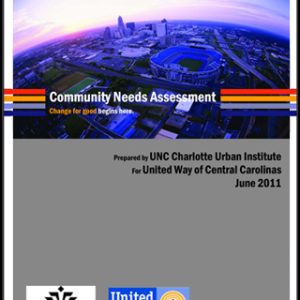Data

United Way of Central Carolinas Needs Assessment 2011 – Full Report
In June 2010, United Way of Central Carolinas commissioned the UNC Charlotte Urban Institute to conduct a comprehensive community needs assessment for its five-county service area. The primary purpose of the study was to pinpoint the community’s greatest needs and identify gaps in the current array of human services. This study is one of several […]

School Readiness Plan
The Larry King Center (LKC) of the Council for Children’s Rights recently released a plan for improving school readiness for the children in Mecklenburg County. “Unlocking the Potential of a Community: The Plan for School Readiness” is based on data, research, and input from six action teams comprised of community leaders, agency directors, and parents […]

United Way of Central Carolinas Needs Assessment 2011 – Executive Summary
In June 2010, United Way of Central Carolinas commissioned the UNC Charlotte Urban Institute to conduct a comprehensive community needs assessment for its five-county service area. The primary purpose of the study was to pinpoint the community’s greatest needs and identify gaps in the current array of human services. This study is one of several […]

Charlotte region ages around a youthful core
In 1960, the median age for the United States was 29.5 years, meaning that half the population was older than that, and half was younger. In the 2010 Census, the median age for the country moved up to 37.2 years, reflecting what many demographers refer to as the “graying of America”. As with other changing […]

Census 2010: North Carolina is 6th-fastest growing in U.S.
An examination of the Census 2010 data released so far provides several insights into how North Carolina’s growth compared to other states. North Carolina was the 6th fastest-growing state in the 2000s at 18.5%, putting it just between Texas and Georgia, and virtually tied with Georgia in growth since the 1990s. That level of growth […]

Census 2010: South Carolina Counties in the Charlotte Region
The recently released South Carolina data from US Census 2010 now allow for a more complete picture of growth in the Charlotte Region in the last decade. The South Carolina counties of Chester, Lancaster and York form the southern flank of the 14-county Charlotte Region. The census data show York County was the second-fastest growing […]

Census 2010: Mecklenburg patterns of residential segregation
Controversies over school closures in Charlotte and Mecklenburg County over the past year have refocused public attention on issues of race in our community. While the explosive growth of the Hispanic population has been a more recent demographic trend, the issue of residential segregation among blacks and whites has a much longer history in this […]

Census 2010: cities and towns in the Charlotte region
On Wednesday, March 2nd, the first set of data from the 2010 Census was released for North Carolina counties, cities, towns, etc., providing the first hard population counts for these areas since 2000. We know that the Charlotte region as a whole has grown rapidly in the last decade, but how has that growth been […]

Charlotte’s rapid growth brings demographic changes
Headlines have highlighted multiple demographic trends affecting Charlotte and the metro area over the last decade. “Carolinas lead the nation in Hispanic growth,” read the headline of a Charlotte Observer story in 2008. The city has ranked highly on “Best City” lists for African Americans throughout the 2000s. Moving beyond the headlines, however, is there […]

The changing face of Mecklenburg
Mecklenburg County, N.C., is home to the state’s largest city, Charlotte. Most people living in Mecklenburg County today were born outside of North Carolina. U.S. Census Bureau data estimates from 2009, released earlier this fall, put that number at just over 58%. The new diversity of the county has some interesting twists. For instance, more […]